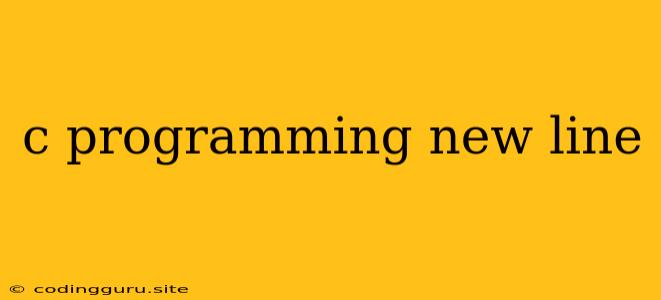Understanding Newlines in C Programming
Newlines are an essential part of any programming language, and C is no exception. They are the invisible characters that tell the compiler to move to the next line of output. Understanding how newlines work is crucial for creating clean and readable code that produces the intended output.
What is a Newline?
In C, a newline character is represented by the special escape sequence \n. This character isn't a visible character like a letter or number, but rather an instruction to the compiler. When the compiler encounters a \n, it moves the output cursor to the beginning of the next line, essentially creating a line break.
How to Use Newlines in C Programs
You can include newlines in your C programs in two main ways:
-
Directly in String Literals:
#includeint main() { printf("This is line 1.\nThis is line 2."); return 0; } This code snippet will print:
This is line 1. This is line 2.As you can see, the
\nin the string literal causes the output to be displayed on two separate lines. -
Using the
puts()function:The
puts()function in C automatically adds a newline character at the end of the string it prints.#includeint main() { puts("This is line 1."); puts("This is line 2."); return 0; } This code will produce the same output as the previous example:
This is line 1. This is line 2.
Why are Newlines Important?
Newlines play a crucial role in making your code readable and output presentable. They:
- Separate Lines of Output: Newlines ensure your program's output is displayed on distinct lines, making it easier to understand and parse.
- Improve Code Readability: Newlines within your C code act as visual cues, separating different parts of your program and making it easier to follow the logic.
Understanding Newlines in Different Contexts
The behavior of newlines can sometimes vary depending on the context:
- Input: When you input text into your program, you usually press the "Enter" key to create a new line. This keystroke is typically translated into a newline character.
- File Handling: When working with files in C, you'll use the
\ncharacter to represent line breaks within the file.
Example: Formatting Output
#include
int main() {
printf("Name: %s\n", "John Doe");
printf("Age: %d\n", 30);
printf("Occupation: %s\n", "Software Engineer");
return 0;
}
This code will print:
Name: John Doe
Age: 30
Occupation: Software Engineer
The \n after each printf() statement ensures that each piece of information is printed on a new line, making the output clear and structured.
Conclusion
Newlines are essential in C programming, influencing both the formatting of your code and the appearance of your program's output. Understanding how to use them effectively will enhance your C programming skills, allowing you to create more readable and user-friendly programs.
